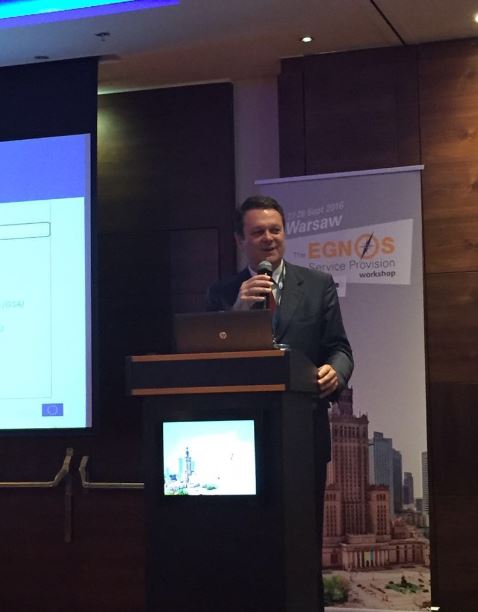European GNSS Agency (GSA) Executive Director Carlo des Dorides meets with EUROCONTROL Director-General Frank Brenner and Director Pan-European Single Sky Adriaan Heerbaart to discuss common concerns and new cooperative activities.
 At a recent meeting in Prague between the GSA and EUROCONTROL all parties agreed that it makes good sense for the GSA to work more closely with EUROCONTROL. The GSA is responsible for the exploitation of the European GNSS systems and EUROCONTROL, the European Organisation for the Safety of Air Navigation, is the manager of the pan-European air traffic management network. The two bodies share many of the same objectives, in particular the spelling out of implementation policies for European satellite navigation in the air traffic management and aviation sectors.
At a recent meeting in Prague between the GSA and EUROCONTROL all parties agreed that it makes good sense for the GSA to work more closely with EUROCONTROL. The GSA is responsible for the exploitation of the European GNSS systems and EUROCONTROL, the European Organisation for the Safety of Air Navigation, is the manager of the pan-European air traffic management network. The two bodies share many of the same objectives, in particular the spelling out of implementation policies for European satellite navigation in the air traffic management and aviation sectors.
With this is mind, following the recommendations on a joint EUROCONTROL-EU Task Force on GNSS of 28 June 2013 and the exchange of letters for the formalisation of the GSA-EUROCONTROL collaboration in September 2014, the two bodies have endeavoured to elaborate an effective cooperation mechanism which was officially formalised in April 2015 with the signature of a Framework Partnership agreement and a First Specific Grant agreement.
The latest meeting, held at GSA headquarters in Prague, represents a key first step for the partnership. This round of talks also brought in the Single-European Sky, a European Commission initiative through which the design, management and regulation of airspace is to be coordinated throughout the European Union.
Essentials
Key topics discussed in Prague include:
The aviation-specific environment and its requirements
• The exploitation of EGNOS and Galileo
• Security for critical aviation systems
• Steps for a long term cooperation
EUROCONTROL Director General Frank Brenner emphasised the excellent teamwork that has already taken place. “All project managers and team members are more than willing to move the cooperation forward,” he said. Carlo des Dorides also pledged the GSA’s full commitment to supporting the partnership.
In concrete terms, the two partners discussed the coordination of the activities in the following fields:
• Area 1: Aviation users’ needs, to support the definition of mission-level requirements for EGNOS
• Area 2: The operational introduction of European GNSS services, EGNOS and Galileo, for aviation in the European Civil Aviation Conference (ECAC) area
• Area 3: Advice on regulatory and standardisation aspects, including spectrum
• Area 4: Support to European GNSS development and exploitation activities
• Area 5: Coordination of R&D for GNSS in aviation
• Area 6: The inclusion of EGNOS and Galileo in future GNSS user terminals for aviation
Good for Everyone
 The potential benefits of GNSS for aviation are by now well known. With its ability to augment existing GNSS signals, EGNOS offers enhanced vertical precision and integrity, i.e. a ‘guaranteed signal’. This means it allows for safer approaches at difficult airstrips or under adverse meteorological conditions.
The potential benefits of GNSS for aviation are by now well known. With its ability to augment existing GNSS signals, EGNOS offers enhanced vertical precision and integrity, i.e. a ‘guaranteed signal’. This means it allows for safer approaches at difficult airstrips or under adverse meteorological conditions.
With EGNOS, optimised and even curved approaches are now on the table, meaning the potential to increase air transport capacity, save fuel and lower noise in populated areas – all to the benefit of airports, airline operators, flying passengers and citizens on the ground.
Also read: EGNOS – The Smart Choice for Aviation
In addition, EGNOS-enabled receivers are widely available, and the system is fully compatible with the US Satellite Based Augmentation System, WAAS, and with Japan’s MSAS. With an on-board EGNOS receiver and an adapted approach procedure, no additional investments in ground infrastructure or maintenance costs are necessary. EGNOS may also make it possible for some airports to eliminate expensive ground-based navigation aids and other infrastructure.
By all accounts, the meeting in Prague was rated a success. Marked by a constructive and cooperative spirit, all three parties welcomed the opportunity to embark on a long-term cooperative partnership.
Given the potential benefits of European GNSS for the aviation sector, this is clearly good news for everyone.
More Information
Media note: This feature can be republished without charge provided the European GNSS Agency (GSA) is acknowledged as the source at the top or the bottom of the story. You must request permission before you use any of the photographs on the site. If you republish, we would be grateful if you could link back to the GSA website (http://www.gsa.europa.eu).